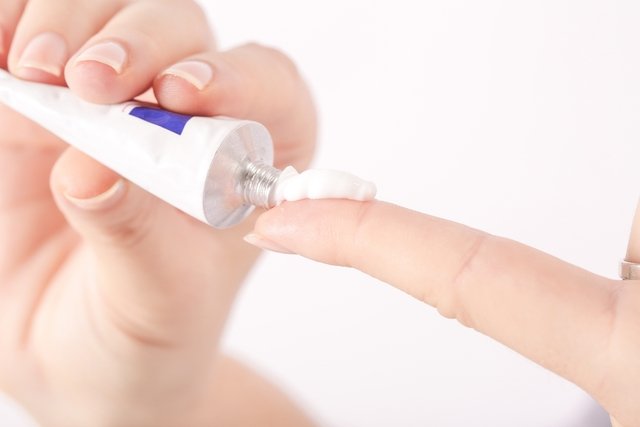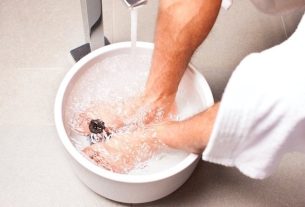Ointments for phimosis, such as Postec ointment or betamethasone ointment, have corticosteroids in their composition, which have anti-inflammatory action and make the skin thinner, easier to stretch and helping to treat phimosis.
The use of ointments for phimosis is mainly indicated for children over 1 year old, if there is no regression of phimosis with spontaneous release of the foreskin, and aims to reduce fibrosis and favor exposure of the glans, helping to alleviate pain and accelerate treatment.
Phimosis ointments should only be used under the guidance of a urologist or pediatrician according to the age and characteristics of the phimosis. Furthermore, it is important that the doctor monitors the evolution of phimosis over time as the ointment is applied, as if there is no improvement, surgery may be recommended. Check out the treatments available to treat phimosis.

Main ointments
Some of the most commonly used ointments to treat phimosis include:
1. Fasting
Postec ointment is specific for phimosis as it contains betamethasone valerate, which is a corticosteroid with anti-inflammatory action that helps make the skin thinner, making it easier to stretch.
Furthermore, this ointment contains hyaluronidase, which is an enzyme that reduces swelling and facilitates the entry of corticosteroids into the skin, facilitating exposure of the glans.
This ointment is usually indicated in cases of congenital phimosis and can be used by children over 1 year of age or people up to 30 years of age.
How to use: apply twice a day, that is, every 12 hours, directly to the skin of the foreskin, for 3 weeks in a row or according to medical advice. After 3 weeks of treatment, you must have a medical evaluation again.
Contraindications: This ointment should not be used by children under 1 year of age and in people who are allergic to any of the components present in the formula or other types of corticosteroids.
Taking care of your health has never been easier!
2. Betamethasone
In some cases, the doctor may recommend the use of only betamethasone valerate ointment for phimosis, which, despite not being specific for phimosis, can be used to help thin the skin, as it is a corticosteroid.
This ointment can be found in its generic form or under the trade name Betnovate and should only be used under medical supervision by children over 1 year of age and adults.
How to use: apply a thin layer of the ointment to the skin of the foreskin 1 or 2 times a day, for a maximum of 4 weeks of treatment, as per medical advice. During treatment, medical consultations should be made, as the doctor may reduce the frequency of application of the ointment, depending on the response to treatment.
Contraindications: This ointment should not be used by children under 1 year of age, or in cases of foreskin skin infections, genital itching, or allergy to betamethasone or other corticosteroids.
3. Hydrocortisone
Hydrocortisone acetate is another ointment that may be recommended by the doctor for phimosis, as it is a low-potency corticosteroid, which can also make the skin thinner, helping to treat phimosis.
This ointment can be found in its generic form as “hydrocortisone acetate” or under the trade names Berlison or Cortigen, for example, and should only be used under medical advice.
How to use: apply a thin layer of the ointment to the skin of the foreskin 2 to 3 times a day, as per medical advice. For infants and children under 4 years of age, treatment should not exceed 3 weeks. After this period, you must have a medical evaluation again.
Contraindications: This ointment should not be used in cases of allergy to hydrocortisone or any other type of corticosteroid.
4. Fludroxycortide
Fludroxycortide ointment is another corticosteroid that, despite not being specific for phimosis, can be recommended by the doctor for the treatment of phimosis, as, in the same way as other corticosteroids, it makes the skin thinner and easier to stretch.
This ointment can be found under the trade name Drenison and should only be used if recommended by your doctor.
How to use: apply a thin layer of fludroxycortide ointment to the skin of the foreskin 3 to 3 times a day, for a maximum of 4 weeks of treatment, as per medical advice.
Contraindications: This ointment should not be used by children under 1 year of age, or in cases of allergies to corticosteroids.
5. Furoato de mometasona
Mometasone furoate is another type of corticosteroid that may be recommended by your doctor for the treatment of phimosis.
This ointment can be found in its generic form containing 1 mg/g of mometasone furoate, or under the trade names Topison, M Lix or Resgat, for example.
How to use: apply a thin layer of mometasone furoate ointment to the skin of the foreskin, once a day, for a maximum of 4 weeks of treatment, as per medical advice.
Contraindications: This ointment should not be used by children under 2 years of age or in cases of allergy to corticosteroids.
6. Clobetasol Propionate
Clobetasol propionate is a very potent corticosteroid that may also be recommended by your doctor for the treatment of severe phimosis.
This ointment can be found as a generic containing 0.5 mg/g of clobetasol propionate, and can be used from 1 year of age onwards, and only with medical advice.
How to use: apply a thin layer of the ointment directly to the skin of the foreskin, 1 to 2 times a day, for a maximum of 4 weeks, as per medical advice.
Contraindications: This ointment should not be used by children under 1 year of age or in cases of untreated skin infections, genital itching or allergy to corticosteroids.
Care when using ointments
Some precautions are important during treatment with phimosis ointments, such as:
- Urinate and then wash and dry the genital region adequately, before applying the ointment;
- Carefully pull the excess skin back without causing any pain;
- Apply the ointment around the entire foreskin, covering from the area at the tip of the penis to where the foreskin meets the skin at the bottom of the penis shaft;
- Gently massage the region so that the ointment is fully absorbed and covers the entire area;
- Place the foreskin skin under the glans again, after applying the ointment;
- Use the ointment recommended by the doctor, at the recommended times and for the indicated treatment time;
- Consult your doctor again after 3 or 4 weeks of treatment to evaluate the effectiveness of using the ointment. In some cases, the doctor may recommend continuing treatment for another cycle of 3 or 4 weeks.
Furthermore, after applying the ointment, the doctor may advise you to perform stretching exercises on the foreskin to reduce and even cure the degree of phimosis.
However, more serious cases, such as Kayaba grades I and II, may be more difficult to treat with the ointment alone, and other forms of treatment are recommended.

Sign up for our newsletter and stay up to date with exclusive news
that can transform your routine!
Warning: Undefined array key "title" in /home/storelat/public_html/wp-content/plugins/link-whisper-premium/templates/frontend/related-posts.php on line 12
Warning: Undefined array key "title_tag" in /home/storelat/public_html/wp-content/plugins/link-whisper-premium/templates/frontend/related-posts.php on line 13



